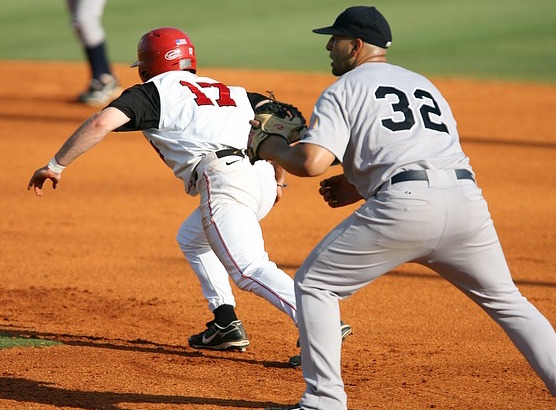Stealing on first-move (Part 3)
September 22, 2017 by Coach McCreary
Filed under Base Running, Coaching, First Base, Pitching, Second Base, Shortstop
This is the final post in a three part series on stealing first-move on a left-handed pitcher. In Part 1, I explained what stealing first-move is and why it can be an effective strategy. In Part 2, I discussed a variety of things the offensive team needs to be aware of and do in order to be more successful. In Part 3, I will wrap things up by explaining what the defense can and should do to prevent the offense from being successful on first-move steal attempts.
Mix up your times. This is probably the biggest thing that shuts down first-moves. A left hander must mix up their times on pick-offs to first base. Big, slow leg kicks on pick-offs are just begging the other team to go first-move. Have several different pick-off moves that include different leg kicks and speeds to first base.
Play proper depth. Under most circumstances, middle infielders must play close enough to the bag so as to get there in time. The trick is when a right-handed batter is up and the shortstop has to play more in the hole. Either way, the shortstop must be able to get to the bag to receive the throw from the first baseman. The second baseman needs to get to the area too if needed but it is a much easier play for the shortstop. He needs to be close enough to the bag to get there in time.
Assume he is going first move. This is also for the shortstop. If there is any delay between the pitcher starting the pick-off to first and the shortstop noticing the runner has taken off then it becomes much more likely the runner will beat the shortstop to second base. Shortstops MUST develop the habit of ALWAYS taking a quick, strong step towards second base immediately upon noticing the pitcher moving towards first on a pick-off. He must assume the runner is going first-move on EVERY SINGLE pick-off attempt. If not, he’ll get caught napping.
Watch the catcher’s signs. This one is for both middle infielders. Both the second baseman and the shortstop must look in and see the catcher’s sign to the pitcher. Very often it is the catcher’s sign that tells the pitcher to throw over to first base to hold the runner close. If the middle infielders look in and see the sign for a pick-off, they also can break on first move since they know a pitch is not being thrown. This obviously makes it easier for them to get to the bag on time.
Don’t wait for the ball. This is for the first baseman. As soon as the first baseman sees that the runner has bolted on first-move, he should immediately leave the bag and move directly towards the pitcher. This allows him to catch the ball sooner which, in turn, allows him to get rid of it sooner. A first baseman should never stay at the bag and wait for the ball to get to him. Save time by going towards the ball. This also helps with the next tip.
Avoid the runner. When the first baseman moves towards the pitcher to catch the ball he creates a better throwing angle to second base which lessens the chance of hitting the runner with the throw to the bag. If the shortstop is where he needs to be (next tip!) then it will typically be an easy throwing lane to second base.
Stay on the infield side of the base line. When the first baseman moves towards the pitcher to catch the throw, he is now on the infield side of the baseline that goes from 1st to 2nd base. As a result, the shortstop not only needs to get to the bag quickly but has to set his feet on the infield side of second base as well. Both fielders are on the same side of the bag which prevents the throw from crossing over the runner’s lane on its way to second base. This is why this play is much easier for the shortstop than the second baseman. The shortstop is already on that side of the bag at his position and just needs to get there in time. The second base needs to get there in time and set up on the opposite side of the bag from which he is coming.
Watch for big leads. When a left hander has a good pick-off move to first base, you typically see the opposing runners significantly shorten their leads off first base. They obviously don’t want to get picked off. However, when they are going first-move, they don’t care if the pitcher throws over. They are banking on making it to second base faster than the ball. As a result, runners going on first-move tend to take bigger leads then normal. First basemen, pitchers, and even catchers (they have a good view of leads) must be able to recognize an abnormal lead and quickly call time out or step off the pitching rubber. Whoever sees it should take a trip to the mound or yell out, “watch first-move!” This puts everyone on higher alert so they can take all the steps I listed above.
The first-move steal of second base is one of those “cat and mouse” games that help make baseball the beautiful game that it is. The average fan has no idea about all the things on both sides of the ball that are happening in front of them on a first-move attempt.
As always, the team that gets more of them right is the team that will be successful when a runner goes on first-move.






Leave a Reply